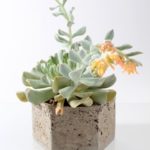ZZ Plant Rocks!
When it comes to rock star houseplants, ZZ (Zamioculcas) tops the charts. The Eastern Africa native flaunts good looks, a great name and an award-winning status. Featuring shiny, dark-green, oval-shaped leaves and an upright growth habit, ZZ turns heads and fits just about any décor. In 2002 and 2009, the plant was even named a “Plant of the Year” by the Florida Nursery, Growers and Landscape Association.
Ancient houseplant
If you’re not familiar with ZZ plant, it was discovered back in the 1800s, but it didn’t really hit the houseplant scene until the 1990s, says Costa Farm’s garden expert Justin Hancock. “ZZ is in the same family as the tough-as-nails Chinese evergreen, pothos and philodendron, but it’s sometimes mistaken for a cycad (an ancient family of plants that includes sago palm) because of its appearance,” he says.

(Photo, Costa Farms)
Easy care indoor plant
It looks like a superstar, but ZZ plant is remarkably low maintenance. “ZZ has a few features that make it an outstanding houseplant,” says Hancock. “The plant tolerates low light better than most indoor plants, so it’s perfect for adding a touch of greenery to just about any corner of your living room – or on your desk at work. It’s also wonderfully tolerant of drought, so if you forget to water it from time to time, it doesn’t miss a beat.”
Hancock offers these tips for keeping ZZ alive and happy in your home.
Avoid cold temperatures. ZZ may be tough and tolerant, but as a tropical plant it doesn’t respond well to temperatures below 50 degrees Fahrenheit. Hancock advises that if you shop for ZZ plant in the winter and live in a cold-winter climate that you have the nursery wrap the plant in plastic before you bring it out into the chill. If you receive a plant via mail, make sure that it doesn’t sit outside during low temperatures.
Watch watering. While ZZ does tolerate drought—even going deciduous if you forget to water, at which point you can bring it back from the brink of death—it does not respond well to overwatering. Excess water quickly leads to root rot and death. Let the plant approach dryness before watering. Generally, this means waiting until the top 2 to 3 inches of soil has dried.
Provide medium to bright light. ZZ plant tolerates low light and periods of drought, but it will grow faster and larger in a brighter spot with more consistent moisture, says Hancock. “The plant is not a particularly fast grower, but over time if you want to see your plant put on more size, you can get it a few feet tall by providing these ideal conditions,” he says. “Big ZZ plants are decidedly more dramatic than the small ones we tend to see in the garden centers.”
Availability. It used to be that ZZ plant was hard to find, but it’s becoming more available. You can often find it via mail-order.





